Most people have heard the phrase, “When life gives you lemons, make lemonade.” The idea, of course, is to make the best of what is dealt to you. If things aren’t quite what you wanted, try to make it into something else.
Although it may not be quite as simple as it sounds, it can be possible to change a negative thought or situation into a positive one. By practicing techniques that help you to alter your perspective and see things in a different way, you may be able to turn your “lemons” into “lemonade.”
Artist Mary Engelbreit said,
“If you can’t change it, change the way you think about it.”
Let’s take a look at a few ways to reframe the negatives into positives.
Refrain or Reframe?
Most people would agree they don’t want to be stuck with negative thoughts running through their minds. It’s a common practice to try not to think about something that’s bothering you.
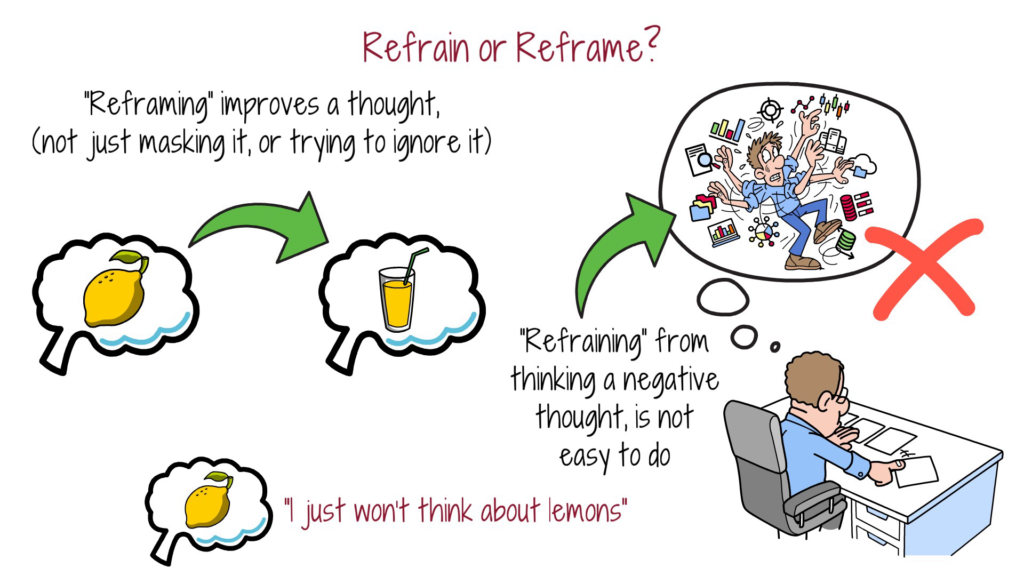
But if you try to simply “refrain” from thinking a negative thought, you’ll soon find that it’s not that easy to do. The more you try “NOT” to think about something, the more you think about it. To just “refrain” from a negative thought is not an easy action to take. When thinking of life bringing you lemons, it would be hard to tell yourself, “I just won’t think about lemons!” The next thing you know, lemons are the only thing on your mind!
Then what about “reframing” a thought? How does that work? Well, essentially, it takes the thought and turns it into something better, not just masking it, or trying to ignore it. Since trying to eliminate the lemon scenario altogether probably won’t be of much help, a better suggestion might be to examine how to make lemons more palatable. That’s when you can change them into lemonade.
Reframe the thought to accommodate something more acceptable. By doing so, you can put a more positive spin on thoughts that have you trapped without a solution. One example might be that if you’re thinking, “I’ll never get this assignment done”, you could reframe that thought by replacing it with, “I’ll finish this assignment tonight by breaking it down into simple steps.”
Another way to look at it is by changing your perspective. For example, when a photographer is sizing up a shot for a particular photo, they will view the subject from various positions before deciding to snap a picture. Depending on the angle of the camera lens, the light, colors and composition, the picture may appear different. When you look at something from another point of view, your “point of view” will change.
Reframing a Negative
“Cognitive Reframing” is a term used to identify negative thoughts and replace them with those that are more balanced. In his book, Feeling Good, Dr. David Burns said,
“When you change the way you think, you can change the way you feel.”
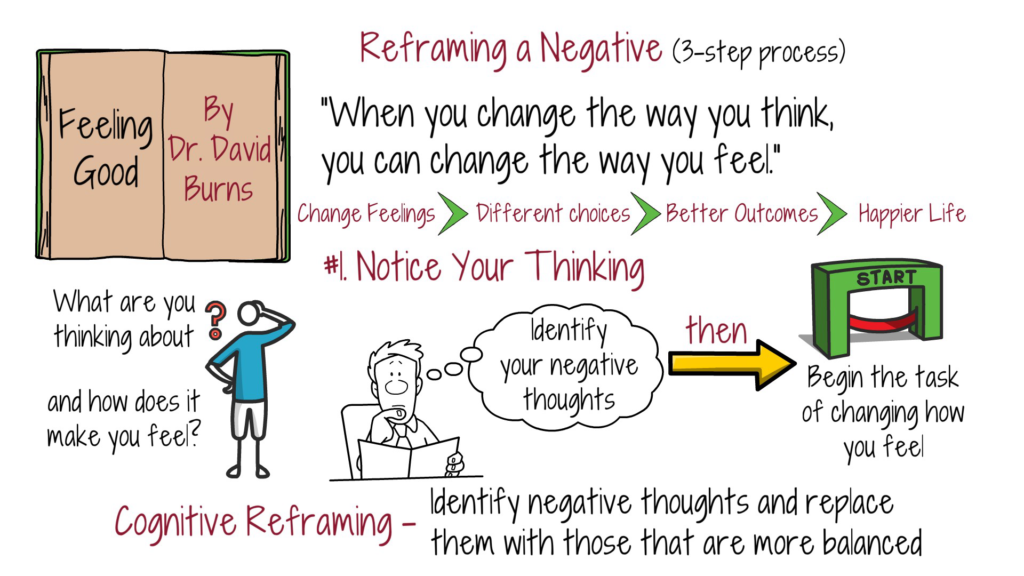
By changing our feelings, we might make choices that result in better outcomes and happier lives.
Here are three steps that may help you begin reframing your negative thoughts:
- Notice Your Thinking
What are you thinking about and how does it make you feel? Are you running a loop of negative self talk? Are you stuck on an event or something someone said and you can’t get it out of your head? Thoughts create feelings. By identifying your negative thoughts, you can begin the task of changing how you feel. - Evaluate the Evidence
Ask yourself if the thoughts you are thinking are true and accurate. If you believe you got dealt a bad hand at something, does that mean you’re always going to be dealt a bad hand from here on out? Once you remove your emotions about the negative thought, focus on the facts. Life events are usually not an all or nothing situation. When you can see the truth about what you’re thinking, you are better equipped to decide if you want to hold the thought or not. - Reframe the thought with compassion
How can you change your perspective to lessen the severity of the negative thought? By using just the facts, not your feelings, how could you change the thought to a positive one? For example, if you are thinking that you always fail at dieting, and you’re always going to be overweight, you might reframe the thought with, “By eating healthy foods and exercising, I can reach my desired weight.” Don’t succumb to defeating yourself with negative thoughts.
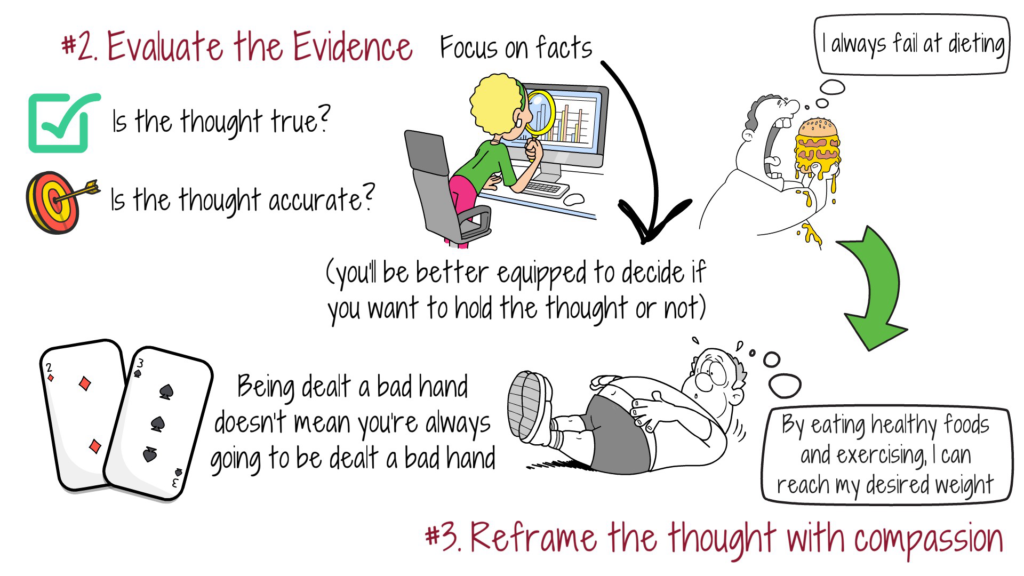
Another way to reframe your negative thoughts is to not jump to conclusions about how you think something may turn out. You may know someone who lost a job or relationship, only to exclaim later that the loss was the best thing that ever happened to them. How can that be? If something doesn’t work out the way you wanted it to, isn’t that a bad thing? Well, not always.
For example, one woman said that in her first year of college, she ended up in a dorm room with someone she couldn’t stand. They had nothing in common and she anticipated a terrible first year of college life. That would seem like a big negative wouldn’t it? But as it turned out, through her roommate, she ended up meeting the person who would become her life partner, and was introduced to some new book topics which became an important new interest for her.
Sometimes negatives can turn into positives on their own! So before making judgements about something, wait until all the information is in. Reframing this situation might sound like, “This isn’t what I had hoped for, but I’m going to give it a chance, and see where it goes.”
Failure and Rejection
Failing at something can seem like an impossible thing to reframe into a positive. After all, it was a failure. There’s no happy ending here, right? Or is there? Is failure always the end? Or is it an opportunity to look at something differently and then try again?
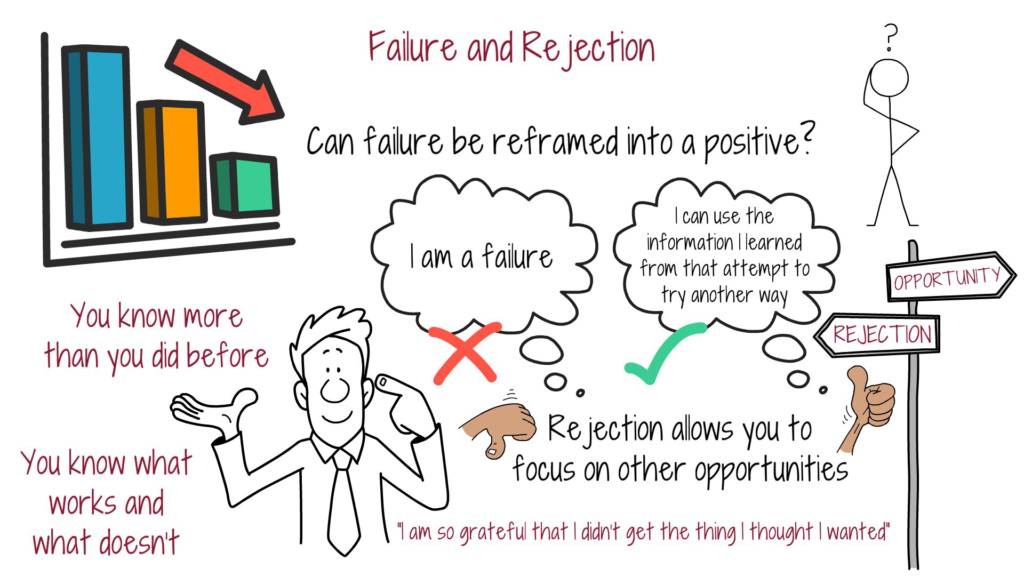
For example, think about what you learned from your failure. Now you know more than you did before. You know what works and what doesn’t. You experienced growth and put yourself in a position of trying new things.
Instead of thinking, “I am a failure”, try reframing that into, “I can use the information I learned from that attempt to try another way.”
And what about rejection? What if you gave something your best shot and it was rejected? Whether it was an attempt at a career goal or a relationship you thought you wanted, rejection could allow you to focus on other opportunities. Maybe you applied for a job you were certain you would get, only to be passed over for another applicant. By reframing this loss and applying elsewhere, you might find the second job turned out to be perfect for you.
So many times, various people have been quoted as saying, “I am so grateful that I didn’t get the thing I thought I wanted.”
Both failure and rejection are inevitable. There are going to be times when things don’t work out the way you planned. But by reframing these negative experiences into positive ones, you can minimize your suffering, and begin to build strength, resilience and maturity.
Here are some reminders for turning negatives to positives:
- Catch your negative thoughts and look at the facts
- Reframe a statement that is both accurate and positive
- Wait until you have all of the information, rather than jumping to conclusions
- Don’t allow your imagination to make up false scenarios
- Remember that just because something happened once, doesn’t mean that’s how it will turn out next time.
Final thoughts
What you think about, you bring about. Being in control of your thoughts can put you in better control of your life. It’s up to you to choose the thoughts that are in your best interest. By reframing the negative thoughts into positive ones, you can make big changes to the way you perceive your circumstances and life experiences.
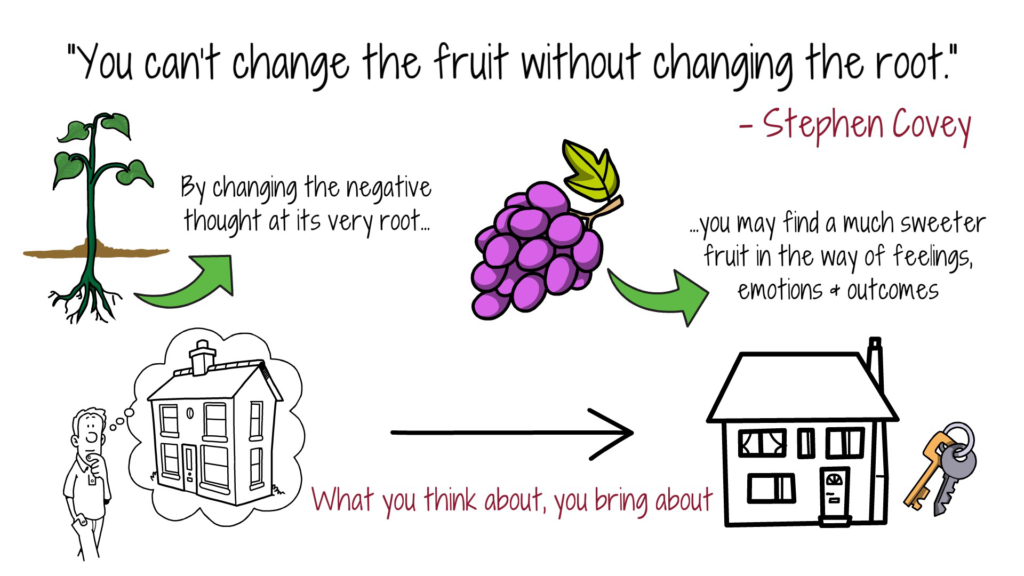
Author Stephen Covey wrote,
“You can’t change the fruit without changing the root.”
By changing the negative thought at its very root, you may find a much sweeter fruit in the way of feelings, emotions and outcomes. As they say, when life gives you lemons, make lemonade.
